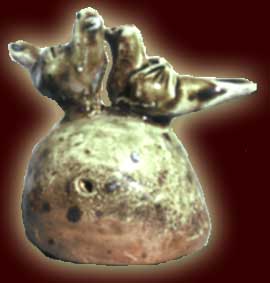 |
: the dialog for love |
||||||||
The whistle is a symbol of the life. It is the "conduit of the breath and the soul" to take up again the expression of Schaeffner in connection about the flute. Its symbolism makes it a privileged instrument for certain rites of seduction. Undoubtedly some whistles uses are also reproductions of the bird parade in love. Evidences of such traditions are found in many European countries. |
|||||||||
| In Italy, during the festival of San Marco on April 25, young men declared their love and guaranteed their virility by offering a whistle in bird shape to their promised. In Luxembourg, during the Easter Monday, young people do the same. In Italy always, in Rutigliano (Bari) at the feastday of Saint Antoine the abbot (January 17), the man gave to his betroth a whistle in the shape of a rooster placed at the center of a basket containing dry fruits and taralli to anise. This gift was a pledge of love and forecast the celebration of a marriage in the year. The promise of fecundity of the whistle is reinforced here by the offer of the fruit basket. This alliance between fruits of the ground and whistles is found in Haute Saone (France) where small wooden whistles are inserted into the back of small gingerbread pigs. Ground fertilized by the breath... This use of the whistle in the rites of seduction is not specific to clay whistles. In France, in Stenay in the Meuse, at the mid-Lent Sunday, during the festival of the "flûteaux" (little flutes), the population was going to Saint Lambert, an old leper-house where existed formerly a hermitage. Young people bought to the merchants tin whistles (these whistles were before in willow) and suspended them by means of pretty ribbons around the neck of the girls whom they preferred. |
|||||||||
 Two tones globular whistle. La Borne (18) Claude Gaget 1999 |
The richest tradition for symbols can be found in Alsace (East of France) in the small hamlet of Saint Gangolphe in the Florival region. A cuckoo market (Kukusmark)was held there and is still held today. Young men bought there air whistles while the girls bought water whistles which they filled at the fountain devoted to the saint. Then, boys and girls lined up on both sides of a path and called out to each others in turn by imitating the song of love of the birds. One will note the female use of a whistle but they are here whistles with water which symbolism of fertility seems to override the symbol of the fertilizing breath. Around Montpellier (France), at the time of village festivals (festivals of the grape harvest?), were held dances around a fire where the boys whistled in clay whistles. Unfortunately, no more precise testimony makes it possible to know the places and precise course of these festivals. These rituals of love are even more explicit in Berry (center of France) where the old inhabitants in La Borne still remember that the boys bought whistles in the shape of phallus to hide them in the pockets of the blouses of the girls. |
||||||||